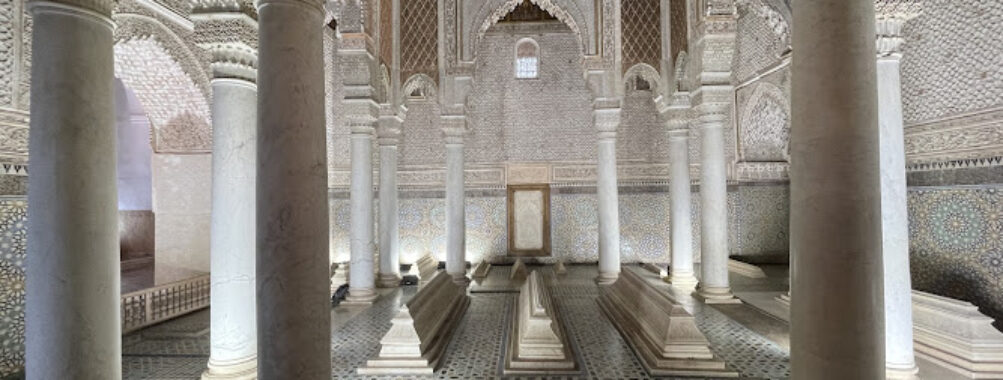
Saadian Tombs
Table of Contents
Description
The Saadian Tombs in Marrakech are one of those places that quietly sneak up on you. For centuries they were sealed off and forgotten, hidden behind walls until rediscovered in 1917. Today, they’re open to travelers from all over the world, and while they can get crowded, there’s still something undeniably magical about stepping into a royal necropolis that dates back to the 16th century. This isn’t just a burial site—it’s a piece of living history, carefully preserved, with gardens, courtyards, and chambers that whisper stories of Morocco’s Saadian dynasty.
Walking through, you’ll notice the details first—the colorful zellij tiles, the carved stucco that seems impossibly delicate, and the Italian Carrara marble that still gleams despite its age. Some people find the space smaller than expected, but the artistry more than makes up for it. Personally, I found myself lingering longer than I thought I would, just staring at the ceilings and wondering how many artisans it took to create such intricate patterns by hand. It’s not a flashy attraction, but it’s deeply atmospheric, and that’s what makes it special.
Key Features
- Royal necropolis with tombs of Saadian sultans, princes, and family members.
- Chamber of the Twelve Columns, the most ornate room, showcasing marble pillars and gilded stucco work.
- Beautifully maintained gardens surrounding the mausoleum, offering a quiet contrast to Marrakech’s busy streets.
- Intricate zellij tilework and Arabic calligraphy that highlight Morocco’s golden age of craftsmanship.
- Wheelchair accessible entrance, making it easier for all travelers to experience the site.
- Family-friendly environment where kids can explore safely while learning about history.
Best Time to Visit
If you want to avoid the long queues (and trust me, they can snake around the corner on busy days), go early in the morning right when it opens. The light is softer then too, which makes the tiles glow in a way that feels almost otherworldly. Late afternoon is another sweet spot, though it can get warm depending on the season. Summer afternoons can be brutal, so if you’re not a fan of heat, stick to mornings. Winter, on the other hand, is mild and pleasant, and you’ll find the crowds a little thinner. I once visited in January and practically had one of the courtyards to myself—it felt like stepping back in time.
How to Get There
The tombs are located within Marrakech’s Kasbah district, right beside the Kasbah Mosque. If you’re staying in the medina, you can easily walk there in about 15–20 minutes, depending on where you’re coming from. The walk itself is part of the fun—you’ll pass narrow alleys, small shops, and the occasional street cat lounging in the sun. If walking isn’t your thing, taxis are plentiful and inexpensive, and most drivers know exactly where the Saadian Tombs are. Just be prepared for traffic near the old city walls, as it can get a little chaotic. Another option is to join a guided walking tour of the medina, which often includes the tombs as a highlight stop.
Tips for Visiting
First and foremost, patience is key. The site isn’t huge, and because of that, lines to enter the main mausoleum chambers can feel a bit slow. But don’t let that put you off—it’s worth the wait. Bring a bottle of water, especially if you’re visiting in the warmer months, because shade can be limited in the courtyards. Comfortable shoes are a must too; the stone floors are uneven in places, and you’ll be on your feet for a while.
If you’re into photography, try to time your visit when the sun isn’t directly overhead. The morning light creates softer shadows, which makes the carvings and tiles pop beautifully in photos. Just be respectful—remember this is still a burial site, and many locals view it as a sacred space. Keep your voice down, avoid touching the walls and decorations, and give others space to enjoy the atmosphere.
Personally, I’d also recommend reading a little about the Saadian dynasty before you go. Knowing that Sultan Ahmed al-Mansour, one of Morocco’s most powerful rulers, is buried here adds a whole new layer of meaning to what you’re seeing. It’s not just pretty tiles and marble—it’s a reminder of a dynasty that shaped Moroccan history. And one last tip: don’t rush. Even if the line behind you feels impatient, take your time to really look up at the ceilings and notice the details. That’s where the magic hides.
Location
Places to Stay Near Saadian Tombs
Find and Book a Tour
Explore More Travel Guides
No reviews found! Be the first to review!